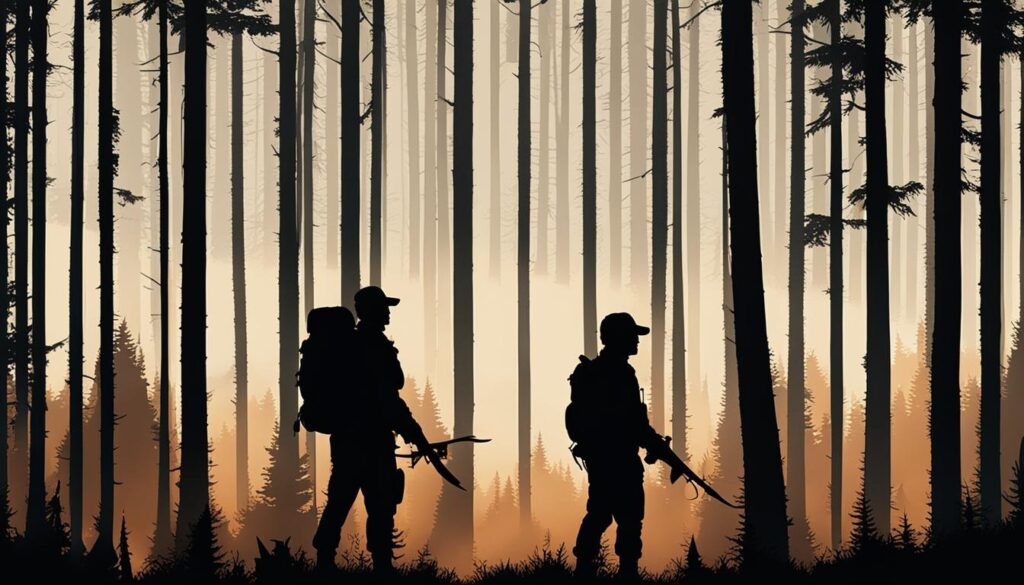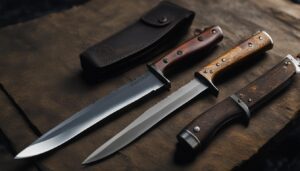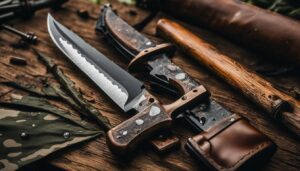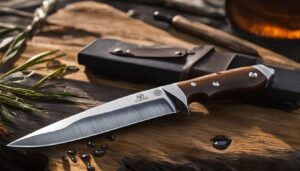When it comes to hunting, having a reliable and sharp knife is crucial. Whether you’re a seasoned outdoorsman or just starting out, proper knife care is essential to ensure your tool stays in optimal condition. In this section, I will share some valuable hunting knife care tips to help you maintain the edge and keep your hunting knives sharp. Let’s dive in!
Key Takeaways:
- Choosing a high-quality hunting knife with a sharp edge is the first step towards proper knife care.
- Invest in sharpening tools such as the Work Sharp guided field sharpener or a traditional sharpening stone to keep your knife sharp.
- Regularly cleaning and oiling your knife will prevent rust and maintain its overall condition.
- When choosing a knife for deer butchering, consider using a set of skinning and butchering knives that feel comfortable in your hand.
- The size and flexibility of the knife will depend on personal preference and the specific cuts you plan to make.
Choosing the Right Knife for Deer Butchering
When it comes to deer butchering, having the right knife is crucial. The choice of knife depends on the specific cuts you plan to make and personal preference. A set of skinning and butchering knives is commonly recommended for this task. Popular options include Benchmade, Morakniv, and Victorinox knives, known for their sharpness and durability.
The size and type of knife will vary based on individual needs. Many hunters prefer a long, flexible fillet knife for skinning and removing fat, while others opt for smaller, more rigid boning knives for precision cuts. It’s important to choose a knife that feels comfortable in your hand and has a blade that holds its edge well.
To illustrate the different types of knives used for deer butchering, here’s a visual comparison:
| Knife Type | Description |
|---|---|
| Skinning Knife | A long, curved knife with a flexible blade used for removing the hide and fat from the deer. |
| Boning Knife | A shorter, rigid knife with a narrow blade used for precise cuts and separating meat from bone. |
| Fillet Knife | A long, thin knife with a flexible blade used for filleting and removing bones from larger cuts of meat. |
Remember to choose a knife that suits your cutting style and needs. The right knife can make a significant difference in the efficiency and accuracy of deer butchering.
Keeping Your Knife Sharp
Keeping your hunting knife sharp is crucial for optimal performance. A dull blade can make it difficult to cleanly and efficiently cut through game, potentially impacting your hunting experience. To maintain a sharp edge, there are several tools and techniques you can use.
One highly recommended sharpening tool is the Work Sharp guided field sharpener. This portable device features ceramic rods and a leather strop, allowing you to quickly and easily maintain a razor-sharp edge. It’s the perfect companion for sharpening your knife in the field.
If you prefer to sharpen your knife at home, a belt sander style sharpener with a blade grinder attachment can be a great option. This type of sharpener provides more heavy-duty sharpening and can help restore a dull blade to its former sharpness.
For quick touch-ups while in the field, a steel or crock stick can be invaluable. These tools allow you to quickly sharpen your knife’s edge, ensuring it remains sharp throughout your hunting trip.
Comparing Sharpening Tools
| Sharpening Tool | Pros | Cons |
|---|---|---|
| Work Sharp Guided Field Sharpener | Portable and easy to use | May not be suitable for heavy-duty sharpening |
| Belt Sander Style Sharpener with Blade Grinder Attachment | Can restore dull blades to sharpness | Requires access to electricity and may be less portable |
| Steel or Crock Stick | Quick and convenient for field use | May not be ideal for extensive sharpening |
Remember, the key to keeping your knife sharp is regular maintenance. Make it a habit to touch up your blade’s edge before each hunting trip, and be sure to clean and oil your knife to prevent rust. By investing in the right sharpening tools and following proper techniques, you can ensure that your hunting knife remains razor-sharp and ready for action.
Cleaning and Maintenance Tips
Proper cleaning and maintenance are essential for keeping your hunting knife in top condition. After each use, it’s important to clean your knife thoroughly with warm water and mild soap. Make sure to dry it completely to prevent rust. Additionally, it’s recommended to regularly oil your knife to protect it from moisture and rust. You can use a light machine oil or a specialized knife oil for this purpose. It’s also a good idea to store your knife in a dry area and avoid exposing it to extreme temperatures or high humidity. Regularly inspect your knife for any signs of damage or wear and address any issues promptly.
When cleaning your knife, it’s important to remove any dirt, debris, or residue that may have accumulated during use. Use a soft brush or cloth to gently scrub the blade, handle, and any other parts of the knife. Pay close attention to the pivot area and locking mechanism if applicable. Rinse the knife thoroughly with warm water to ensure that all soap or cleaning agents are removed. Dry the knife completely with a clean towel or cloth to prevent moisture from causing rust or corrosion.
In addition to regular cleaning, proper maintenance involves keeping your knife well-oiled. Applying a thin layer of oil to the blade and other metal parts will help protect them from moisture and prevent rust. Use a light machine oil, such as mineral oil or a specialized knife oil, and apply it sparingly. Avoid using excessive amounts of oil, as this can attract dust and dirt. After applying the oil, use a clean cloth to gently spread it over the metal surfaces of the knife. Finally, store your knife in a dry place, away from moisture and humidity, to further prevent rust and corrosion.
| Knife Cleaning and Maintenance Tips |
|---|
| Thoroughly clean your knife with warm water and mild soap after each use. |
| Dry your knife completely to prevent rust and corrosion. |
| Regularly oil your knife with a light machine oil or specialized knife oil. |
| Store your knife in a dry area and avoid extreme temperatures and high humidity. |
| Inspect your knife for any signs of damage or wear and address issues promptly. |
By following these cleaning and maintenance tips, you can ensure that your hunting knife remains in optimal condition and ready for your next outdoor adventure.
Sharpening Techniques
When it comes to keeping your hunting knife sharp, there are various techniques and methods you can use. Sharpening your knife not only ensures optimal performance but also extends its lifespan. Here are some professional sharpening techniques to help you achieve a razor-sharp edge:
1. Using a Sharpening System
A sharpening system is a popular choice among hunters as it provides consistency and precision. These systems clamp the knife securely and guide the blade into the sharpening stone at the correct angle. This method helps maintain a consistent edge throughout the entire length of the blade.
2. Diamond Stones or Flat Stones
If your knife is dull and needs a rough edge, using diamond stones or flat stones can be effective. These abrasive surfaces can remove more material from the blade, creating a new edge. Start with a coarser grit and gradually move to a finer grit for a sharper edge.
| Sharpening Method | Pros | Cons |
|---|---|---|
| Using a Sharpening System | Consistent and precise sharpening, suitable for beginners | May require an initial investment |
| Diamond Stones or Flat Stones | Removes more material for a rough edge | Requires practice to maintain the correct sharpening angle |
3. Steel or Crock Stick
For a quick touch-up in the field, using a steel or crock stick is a handy technique. These tools help realign the knife’s edge without removing much material. Simply hold the stick at the correct angle and run the blade down its length several times to sharpen the edge.
“Proper sharpening techniques can make a world of difference in the performance of your hunting knife. Take your time, practice, and find a method that works best for you.”
Remember, sharpening your hunting knife is a skill that requires practice. It’s essential to maintain a consistent angle and not overdo it, as this can result in a rounded edge. With patience and the right tools, you can achieve a sharp and reliable edge on your hunting knife, ensuring a successful outdoor adventure.
Recommended Knife Brands
When it comes to hunting knives, choosing the right brand plays a significant role in ensuring the durability, sharpness, and performance of your tool. Among the top hunting knife brands recommended by experienced hunters and outdoor enthusiasts are Benchmade, Morakniv, and Victorinox.

Benchmade is renowned for its high-quality knives, meticulously crafted with precision and expertise. The brand offers a wide range of hunting knives that are known for their exceptional cutting edge retention, superior ergonomics, and rugged design. Benchmade knives are trusted by professionals and are a favorite among avid hunters for their reliability and longevity.
Morakniv, a Swedish brand with a rich heritage, is highly regarded for its affordability and practicality. Morakniv hunting knives are known for their razor-sharp blades, excellent grip, and easy maneuverability. The brand’s commitment to quality craftsmanship ensures that their knives withstand the rigors of outdoor adventures.
Victorinox, a brand synonymous with Swiss precision and excellence, offers hunting knives that combine elegance with functionality. Known for their meticulous attention to detail, Victorinox knives are favored for their sharpness, reliability, and versatility. The brand’s dedication to craftsmanship and innovation is evident in every knife they produce.
Comparison of Recommended Knife Brands
| Brand | Key Features | Price Range |
|---|---|---|
| Benchmade | Durable, excellent cutting edge retention, superior ergonomics, rugged design | $100 – $500+ |
| Morakniv | Razor-sharp blades, excellent grip, easy maneuverability | $20 – $100 |
| Victorinox | Sharpness, reliability, versatility, Swiss precision | $30 – $200 |
Ultimately, the best knife brand for you will depend on your personal preferences, budget, and specific needs. Whether you prioritize cutting edge retention, affordability, or Swiss precision, these recommended knife brands offer a range of options to suit every hunter’s requirements. Choose a brand that aligns with your hunting style and enjoy the confidence that comes with owning a high-quality hunting knife.
Conclusion
Taking care of your hunting knife is essential for ensuring its longevity and maintaining its cutting edge. By choosing the right knife, regularly sharpening and cleaning it, and following proper maintenance techniques, you can keep your hunting knife in optimal condition.
Whether you’re a seasoned hunter or just starting out, these knife care tips will help you keep your trusty tool razor-sharp and rust-free for all your outdoor adventures. Remember to always prioritize safety when handling and using knives and to follow local regulations and guidelines.
Happy hunting!
FAQ
What are some popular hunting knife brands?
Benchmade, Morakniv, and Victorinox are reputable brands favored by many hunters for their durability and performance.
How do I keep my hunting knife sharp?
You can use tools such as the Work Sharp guided field sharpener, a belt sander style sharpener, or a traditional sharpening stone to maintain a sharp edge on your knife.
What is the best knife for deer butchering?
Many hunters recommend using a set of skinning and butchering knives from brands like Benchmade, Morakniv, and Victorinox for their sharpness and durability.
How do I clean and maintain my hunting knife?
Thoroughly clean your knife with warm water and mild soap after each use, and regularly oil it to prevent rust. Store it in a dry area and inspect it for damage or wear.
What are some techniques for sharpening my hunting knife?
You can use a sharpening system, a diamond or flat stone, or a steel or crock stick to sharpen your knife. Maintain the same angle and avoid over-sharpening.
How can I choose the right hunting knife?
Choose a knife that feels comfortable in your hand and has a blade that holds its edge well. Consider the type of cuts you plan to make and your personal preferences.
Why is it important to take care of my hunting knife?
Proper care and maintenance ensure the longevity and performance of your hunting knife. It helps maintain a sharp edge, prevents rust, and extends the overall lifespan of the knife.





